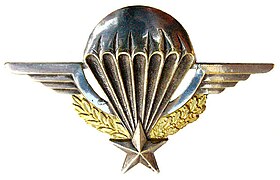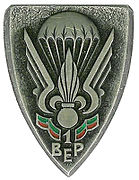1st Foreign Parachute Heavy Mortar Company
| 1st Foreign Parachute Heavy Mortar Company (1re Compagnie Etrangère Parachutiste de Mortiers Lourds) | |
|---|---|
 Company Insignia | |
| Active | September 1, 1953 - May 31, 1954 |
| Disbanded | August 1954 |
| Country | |
| Allegiance | |
| Branch | |
| Type | Foreign Airborne Mortar Unit |
| Role | Infantry support |
| Size | 120 men |
| Part of | Attached to 1st Foreign Parachute Battalion |
| Garrison/HQ | Quynh Loi, Hanoi, French Indochina |
| Colors | Green & Red |
| Equipment | Twelve (12) type 120mm mortars |
| Engagements | Operation Castor Battle of Dien Bien Phu |
| Commanders | |
| Notable commanders | Jacques Molinier Erwin Bergot Paul Turcy |
| Insignia | |
| Identification symbol | 1er CEPML |


The 1st Foreign Parachute Heavy Mortar Company (Template:Lang-fr) was an ephemeral foreign airborne heavy mortar company of the French Foreign Legion which fought during the First Indochina War at the corps of the French Far East Expeditionary Corps.
History
In August 1953, lieutenant Jacques Molinier serves in the 1st Vietnamese Parachute Battalion (1er BPVN). Accordingly, he is tasked by the headquarters of Hanoi to form a heavy mortar parachute combat company integrated in the French Foreign Legion and based in Tonkin. Created on September 1, 1953, based on elements, mainly artillery specialist of the 1st Foreign Parachute Battalion (1er B.E.P) and 2nd Foreign Parachute Battalion (2e B.E.P); the created combat company is administratively attached to the 1st Foreign Parachute Battalion (1er B.E.P).[1] The rear base of the company is situated at Quynh Loï, South of Hanoï.
The first operation launched by the 1st Foreign Parachute Heavy Mortar Company (1re C.E.P.M.L) was to support of the 1st and 2nd Foreign Parachute Battalions. The company also made a combat jump alongside Chef de Battalion Marcel Bigeard's 6th Colonial Parachute Battalion.
On November 21, 1953, Lieutenant Molinier jumped on Dien Bien Phu with the first wave of Operation Castor, at the border Landing Zone (L.Z) Natacha.[2] at 1500, 67 enlisted and officers, as well as 8 type 120mm mortars and 800 rounds of ammunition are dropped on the landing zone. At 1600, the company was in position to fire. This company is the first heavy 120mm mortar unit to be dropped in an airborne type operation. The 1st Foreign Parachute Heavy Mortar Company had packed the mortars in alvéoles type compartments about 3 to 4 meters in diameter. Following the drop, the company received another drop of a supplementary 4 type 120mm mortars to make the total count of 12 type 120mm mortars available for 99 officers, warrant officers, non-commissioned officers and legionnaires.
On March 12, 1954, Lieutenant Molinier is wounded during a recon operation conducted with the 1st Foreign Parachute Battalion 1er BEP on “Béatrice”. Attained by a dozen of mortar shrapnel shells in the back and face, he is carried to the underground hospital of commandant-doctor Paul-Henri Grauwin, who takes the decision to evacuate him by plane to Hanoi. For the officer, the Battle of Dien Bien Phu is over. Molinier passes command of the company to Lieutenant Paul Turcy who is killed on March 14, 1954. Accordingly, Lieutenant Erwan Bergot assumes interim command of the company until the parachute support of Lieutenant Jean Singland. On May 7, 1954, the final assault commenced and the French Foreign Legion launched their mortar response in all directions.
On June 1, the 1st Foreign Parachute Heavy Mortar Company was dissolved. In its eight-month existence, the company fired more than 30,000 rounds and endured heavy losses: 24 killed, 43 wounded. At the liberation of the prisoners from the Viet-minh camps, only 17 had survived. Following the dissolution of the company, Lieutenant Molinier assumed command of the Command and Support Company (C.C.S) of the 1st Foreign Parachute Battalion (1er B.E.P).
Organization
This section is empty. You can help by adding to it. (September 2015) |
Traditions

-
Circled Winged Armed Dextrochere worn on Green Beret of Foreign Legion Paratroopers
Insignias
The insignia of the Foreign Legion Paratroopers of France represents a closed "winged armed dextrochere", meaning a "right winged arm" armed with a sword pointing upwards. The Insignia makes reference to the Patron of Paratroopers. In fact, the Insignia represents "the right Arm of Saint Michael", the Archangel which according to Liturgy[dubious – discuss] is the "Armed Arm of God". This Insignia is the symbol of righteous combat and fidelity to superior missions.
-
1er B.E.P Insignia
-
1st Vietnamese Parachute Battalion Insignia

(1921-2005)
Company Colors
This section is empty. You can help by adding to it. (September 2015) |
Company Song
This section is empty. You can help by adding to it. (September 2015) |
Decorations
This section is empty. You can help by adding to it. (September 2015) |
Honours
Battle honours
This section is empty. You can help by adding to it. (September 2015) |
Company Commander
- 1953 - 1954 : Lieutenant Molinier
- 1954 - 1954 : Lieutenant Turcy
- 1954 - 1954 : Lieutenant Erwan Bergot
- 1954 - 1954 : Lieutenant Singland
Notable Officers and Legionnaires
This section is empty. You can help by adding to it. (September 2015) |
See also
References
- Braby, Wayne & Windrow, Martin. French Foreign Legion Paratroops. London: Osprey Publishing, 1985. ISBN 978-0-85045-629-5
- Collectif, Histoire des parachutistes français, Société de Production Littéraire, 1975.
- Jean Brunon et Georges Manue, Le livre d’or de la Légion étrangère (1831-1955), éditions Charles Lavauzelle et Cie, 1958.
- Pierre Montagnon, Les parachutistes de la Légion 1948-1962, éditions Pygmalion, 2005, ISBN 978-2-85704-940-1.
- ^ Braby & Windrow, Wayne & Martin (1985). French Foreign Legion Paratroops. Osprey Books Ltd. p. 12. ISBN 978-0-85045-629-5.
- ^ Braby & Windrow, Wayne & Martin (1985). French Foreign Legion Paratroops. Osprey Books Ltd. p. 13. ISBN 978-0-85045-629-5.







